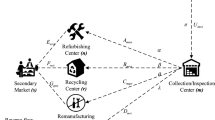Abstract
Modern businesses face a more severe and challenging environment than before. For example, if an enterprise is requested to provide adequate commodities to its customers in different areas, it should be able to determine its own supply chain (SC) at the lowest-cost level immediately. If the enterprise’s response is not in time, the customers will feel unsatisfied and reduce their loyalty. The SC problem is formulated as a multi-level decision making problem in this study. Study results show that the fuzzy multi-objective approach can easily provide a satisfied solution at an acceptable achievement level of desired goals. Therefore, our study is valuable when designing a large-scale SC for practical use.
Access this chapter
Tax calculation will be finalised at checkout
Purchases are for personal use only
Preview
Unable to display preview. Download preview PDF.
Similar content being viewed by others
References
Bard, J. F. and Falk, J. E., “An explicit solution to the multi-level programming problem,” Computers and Operations Research, Vol. 9, No. 1, pp. 77–100, 1982.
Bellman, R. E. and Zadeh, L. A., “Decision making in fuzzy environment,” Management Science, Vol. 17B, No. 3, pp. 141–164, 1970.
Bhattacharya U., Rao, J. R. and Tiwari, R. N., “Fuzzy Multi-criteria Facility Location Problem,” Fuzzy Sets and Systems, Vol. 51, No. 3, pp. 277–287, 1992.
Bourland, K. E., Powell, S. G. and Pyke, D. F., “Exploiting timely demand information to reduce inventories,” European Journal of Operational Research, Vol. 92, No. 2, pp. 239–253, 1996.
Current, J. R., ReVelle, C. S. and Cohon, M. B., “The maximum covering/shortest path problem: A multiobjective network design and routing formulation,” European Journal of Operational Research, Vol. 21, No. 1, pp. 189–199, 1985.
Demeulemeester, E. and Herroelen, W, “A branch-and bound procedure for the multiple resource-constrained project scheduling problem,” Management Science, Vol. 38, No. 12, pp. 1803–1818, 1992.
Fedrizzi, M., Kacprzyk, J., and Roubens, M., Interactive Fuzzy Optimization, Spring-Verlag, New York, 1991.
Goldberg, D. E., Genetic Algorithms in Search, Optimization and Machine Learning, Addison Wesley Publishing Co., Massachusetts, 1989.
Hannan E. L., “Linear Programming with Multiple Fuzzy Goals,” Fuzzy Sets and Systems, Vol. 6, No. 1, pp. 235–248, 1981.
Ida, K. and Gen, M., “Improvement of Two-phase Approach for Solving Fuzzy Multiobjective Linear Programming,” Journal of Japan Society for Fuzzy Theory and Systems, Vol. 9, No. 1, pp. 115–121, 1997.
Lee, E. S. and Li, R. J., “Fuzzy multiple objective programming and compromise with Pareto optimum, ” Fuzzy Sets and Systems, Vol. 53, No. 3, pp. 275–288, 1993.
Martison, F. K., “Fuzzy vs. Minmax Weighted Multiobjective Linear Programming: Illustrative Comparison,” Decision Sciences, Vol. 24, No. 4, pp. 809–824, 1993.
Michalewicz, Z., Genetic algorithms + Data Structures = Evolution Programs, Springer-Verlag Press, Berlin, 1996.
Oxe, G., “Reducing overcapacity in chemical plants by linear programming,” Decision Sciences, Vol. 24, No. 4, pp. 809–824, 1993.
Petrovic, D., Roy, R. and Petrovic, R., “Modeling and simulation of a supply chain in an uncertain environment,” European Journal of Operational Research, Vol. 109, No. 2, pp. 299–309, 1998.
Pyke, D. F. and Cohen, M. A., “Performance characteristics of stochastic integrated production-distribution systems,” European Journal of Operational Research, Vol. 68, No. 1, pp. 23–48, 1993.
Rasmusen, E., GAMES AND INFORMATION: AN INRRODUCTION TO GAME THEORY, Blackwell Publishers, Oxford, 1989.
Sakawa M., Fuzzy Sets and Interactive Multiobjective Optimization, Plenum Press, New York, 1989.
Sakawa, M., Kato, K., Sunada, H. and Shibano, T., “Fuzzy Programming for Multiobjective 0–1 Programming Problems through Revised Genetic Algorithms,” European Journal of Operational Research, Vol. 97, No. 2, pp. 149–158, 1997.
Sarkis, J., “Evaluating environmentally conscious business practices,” European Journal of Operational Research, Vol. 107, No. 1, pp. 159–174, 1998.
Shih, H-S, Lai, Y-J and Lee, E. S., “Fuzzy approach for multi-level programming problems,” Computers Operations Research, Vol. 23, No. 1, pp. 73–91, 1996.
Thomas, D. J. and Griffin, P. M., “Coordinated supply chain management,” European Journal of Operational Research, Vol. 94, No. 1, pp. 1–15, 1996.
Tyndall, G., Gopal, C., Partsch, W. and Kmuauff, J, Supercharging Supply Chains: New ways to increase value through global operational excellence, John Wiley Sons, Inc., 1998.
Tzeng, G. H. and Tsaur, S. H., “Application of Multiple Criteria Decision Making for Network Improvement Plan Model,” Journal of Advanced Transportation, Vol. 31, No. 1, pp. 49–74, 1997.
Tzeng, G. H. and Chen, Y. W., “Implementing an Effective Schedule for Reconstructing Post-earthquake Road-network Based on Asymmetric Traffic Assignment— An Application of Genetic Algorithm,” International Journal of Operations and Quantitative Management (IJOQM), Vol. 4, No. 3, pp. 229–246, 1998.
Vidal, C. J. and Goetschalckx, M., “Strategic production-distribution models: a critical review with emphasis on global supply chain models,” European Journal of Operational Research, Vol. 98, No. 1, pp. 1–18, 1997.
Yu, P. L. and Seiford, L., Multilevel Decision Problems with Multiple Criteria Analysis — Operation Method, edited by Nijkamp, P., Gover Publishers, 1981.
Author information
Authors and Affiliations
Editor information
Editors and Affiliations
Rights and permissions
Copyright information
© 2002 Springer-Verlag Berlin Heidelberg
About this paper
Cite this paper
Chen, YW., Tzeng, GH. (2002). Fuzzy Multi-objective Approach to the Supply Chain Model. In: Trzaskalik, T., Michnik, J. (eds) Multiple Objective and Goal Programming. Advances in Soft Computing, vol 12. Physica, Heidelberg. https://doi.org/10.1007/978-3-7908-1812-3_17
Download citation
DOI: https://doi.org/10.1007/978-3-7908-1812-3_17
Publisher Name: Physica, Heidelberg
Print ISBN: 978-3-7908-1409-5
Online ISBN: 978-3-7908-1812-3
eBook Packages: Springer Book Archive



